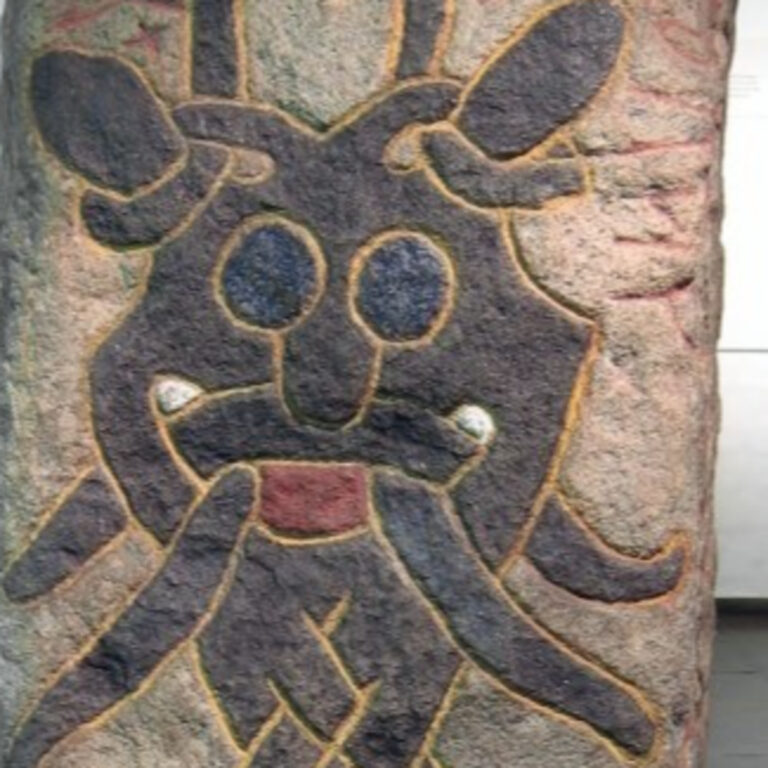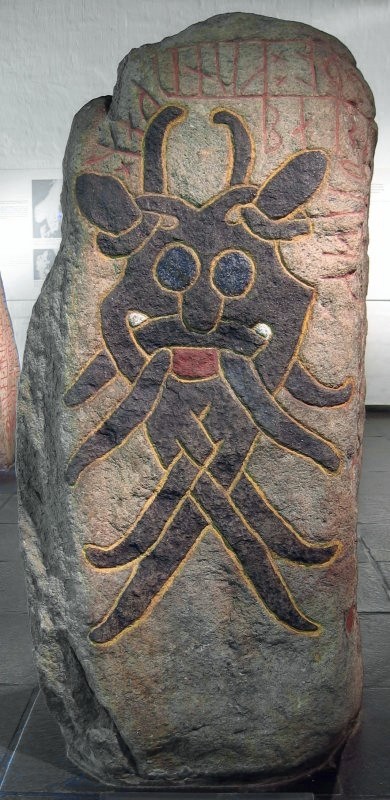21 februar 2025 | 17 minutt

Norsk for Beginners is a podcast aimed at beginners of Norwegian (A1-A2). The episodes are structured in two parts: One Norwegian speaking part and the second in English, explaining the Norwegian part and examining some Norwegian vocabulary used in the episode. I speak Norwegian in a clear, slow and deliberate manner, perfect for beginners. Get some listening practice by listening to “Norsk for Beginners”!
Buy the book here: https://buy.stripe.com/bIYdT7dCM1wLeVGdQQ?locale=en&__embed_source=buy_btn_1QhRZFLUx0JXaC0N4FoHRjI1
More information about the book:Shop – Lær norsk nå
——————————————————————-
Email: Laernorsknaa@gmail.com
Transcript: https://laernorsknaa.com/how-old-is-norse-mythology/
Support me here –>
Patreon: https://www.patreon.com/laernorsknaa
Donasjon (Paypal): Doner (paypal.com)
Bilde: Maskestenen på Moesgård museum. Gardar Rurak (2007).

Transcript
Hei der alle sammen! In this episode, we will discuss the Norse myths and how old they really are. Before we start, I want to quickly mention that you can still by my new book “Learn Norwegian with Norse Mythology”. It contains an introduction and ten Norse myths that I have rewritten for you. You will get both the e-book and audiobook when you buy the book from the link in the description. More information at the end of the episode.
Bilde: Maskestenen på Moesgård museum. Gardar Rurak (2007).
Hvor gamle er de norrøne mytene?
Norrøn mytologi handler om guder og myter fra vikingtiden. Du har sikkert hørt om Odin, Tor og Loke. Kanskje du også har hørt om Yggdrasil, Midgard og Ragnarok? Alt dette kommer fra norrøn mytologi.
De norrøne mytene vi har i dag kommer særlig fra to bøker: Den yngre Edda og Den eldre Edda. Begge disse bøkene ble skrevet på 1200-tallet på Island av kristne mennesker i et kristent samfunn. Men de norrøne mytene er mye eldre.
Vi vet at norrøn mytologi var en del av livet til folk som snakka norrønt. Dette språket ble brukt fra ca. år 700. Mennesker som bodde i Skandinavia på denne tida fortalte de norrøne mytene til hverandre. De norrøne mytene var en del av vikingenes kultur, samfunn og religion.
Mange forskere tror derimot at de norrøne mytene er enda eldre. De tror at de norrøne mytene oppstod lenge før år 700. For eksempel har vi arkeologisk materiale som nevner Odin fra år 400. I 2020 fant arkeologer i Danmark et gullsmykke fra 400-tallet. På smykket står det: «Han er Odins mann». Dette er den eldste skrifta som nevner Odins navn.
I tillegg har arkeologer funnet andre ting fra 400- og 500-tallet som viser ting fra norrøn mytologi. For eksempel så har man funnet smykker som viser Tyr og Fenrisulven, Midgardsormen og Balder. Dette betyr at norrøn mytologi oppstod lenge før vikingtida. Mennesker fortalte versjoner av norrøne myter allerede på 400-tallet.
Er det mulig at norrøn mytologi er enda eldre? For eksempel er det flere likheter mellom gresk og norrøn mytologi. Myter og religioner fra folk som snakka indo-europeiske språk har mange slike likheter. For eksempel så er det mange likheter i kosmologi, skapelsesmytene, gudelæren og offerritualer. Norrøn mytologi kommer sannsynligvis fra indo-europeiske myter som er flere tusen år gamle.
Skapelsesmyten om Yme, den første jotnen, er spesielt spennende. Odin og de to brødrene hans dreper Yme og lager verden av kroppsdelene hans. Denne myta kan dere lese i boka mi. Den ligner på gammelindiske og persiske myter. I iranske myter er Yima opphavet til mennesker. I indiske myter er Yama det første mennesket som dør. Det kan være at norrøne Yme, persiske Yima og indiske Yama har samme opphav. På Patreon legger jeg ved en bonusepisode om den persiske myta om Yima.
Norrøn mytologi har også mye til felles med gammel germansk mytologi. I Tyskland og Storbritannia har man funnet gamle tekster som nevner guder som Odin, Frigg og Balder. Anglosakserne kalte Odin for Wōden og i Tyskland Wuotan.
Den romerske forfatteren Tacitus skriver om den germanske gudinnen Nerthus i år 98 e.kr. Noen tror at dette kan ha sammenheng med den senere norrøne guden Njord. Både den germanske Nerthus og den norrøne Njord er guder for fruktbarhet. Dette er 300 år før de første arkeologiske skriftlige kildene om Odin.
Norrøn mytologi var ikke alltid den samme. Mytene endra seg litt etter hvert som folk fortalte dem videre. Forskerne tror også at noen guder var viktigere før enn de var i vikingtida.
For eksempel var guden Ull en viktig gud i veldig gamle tider, men han ble mindre viktig seinere. Mange steder i Norge har fortsatt navn som kommer fra Ull, for eksempel Ullensaker kommune, kommunen hvor Oslo lufthavn ligger, og stedet Ullensvang.
Et annet eksempel er jotunen Skade som har gitt navn til området Skåne i Sverige og Skøyen i Norge. Hun var kona til Njord. Noen tror at hun kan ha gitt navnet til Skandinavia også. Skade var mye mer sentral før enn i de norrøne mytene vi kjenner til. Navnet Skade har vi også i seinantikken, allerede så tidlig som 300-tallet f.Kr.
Vi vet ikke helt hvor gammel norrøn mytologi er. Vi har ganske gode kilder på at de norrøne mytene slik vi kjenner dem i dag eksisterte på 400-tallet. Men hva er egentlig norrøn mytologi? Mytene og gudene endra seg akkurat som samfunnene endra seg. Navn på guder kunne endre seg. Noen guder ble viktigere, mens andre ble mindre viktige. Det er fortsatt mye vi ikke vet! Men vi vet i hvert fall at norrøn mytologi er mye eldre enn vikingtida.
Hold old are Norse Myths?
Norse mythology is about gods and myths from the Viking Age. You have probably heard of Odin, Thor, and Loki. Maybe you’ve also heard of Yggdrasil, Midgard, and Ragnarok? All of these come from Norse mythology.
The Norse myths we have today mainly come from two books: The Younger Edda and The Elder Edda. Both of these books were written in the 13th century in Iceland by Christian writers in a Christian society. However, the Norse myths themselves are much older.
We know that Norse mythology was a part of daily life for people who spoke Old Norse. This language was used from around the year 700. People living in Scandinavia at the time told Norse myths to each other. These myths were an important part of Viking culture, society, and religion.
Many scholars, however, believe that Norse myths are even older. They think that Norse mythology originated long before the year 700. For example, archaeological evidence mentioning Odin dates back to the year 400. In 2020, archaeologists in Denmark discovered a gold pendant from the 5th century with an inscription that reads: “He is Odin’s man.” This is the oldest written record of Odin’s name.
Additionally, archaeologists have found other artifacts from the 5th and 6th centuries that depict elements of Norse mythology. For instance, jewelry has been discovered featuring Tyr and the Fenrir wolf, the Midgard Serpent, and Balder. This suggests that Norse mythology emerged long before the Viking Age. People were already telling versions of Norse myths in the 5th century.
Could Norse mythology be even older? There are several similarities between Greek and Norse mythology. Myths and religions from Indo-European-speaking peoples share many such similarities. For example, there are common themes in cosmology, creation myths, gods, and sacrificial rituals. Norse mythology likely originates from Indo-European myths that are several thousand years old.
The creation myth of Ymir, the first giant, is particularly interesting. Odin and his two brothers kill Ymir and create the world from his body parts. This myth is described in my book. It resembles ancient Indian and Persian myths. In Iranian mythology, Yima is the ancestor of humanity. In Indian mythology, Yama is the first human to die. It is possible that the Norse Ymir, the Persian Yima, and the Indian Yama share a common origin. On Patreon, you can hear a bonus episode on the Iranian myth of Yima.
Norse mythology also has much in common with ancient Germanic mythology. In Germany and Britain, old texts mention gods like Odin, Frigg, and Balder. The Anglo-Saxons called Odin Wōden, and in Germany, he was known as Wuotan.
The Roman writer Tacitus wrote about the Germanic goddess Nerthus in the year 98 AD. Some believe that she may be connected to the later Norse god Njord. Both the Germanic Nerthus and the Norse Njord are fertility deities. This was 300 years before the first written archaeological sources mentioning Odin.
Norse mythology was not always the same. The myths changed over time as they were passed down. Scholars also believe that some gods were more important in earlier times than they were during the Viking Age.
For example, the god Ullr was very significant in ancient times, but he became less important later. Many places in Norway still have names derived from Ullr, such as Ullensaker municipality (where Oslo Airport is located) and Ullensvang.
Another example is the giantess Skadi, who gave her name to the region of Skåne in Sweden and Skøyen in Norway. She was married to Njord. Some believe that she may have even inspired the name Scandinavia. Skadi was much more prominent in earlier times than in the Norse myths we know today. Her name appears as early as the 4th century BC.
We do not know exactly how old Norse mythology is. We have strong evidence that the Norse myths, as we recognize them today, existed by the 5th century. But what exactly is Norse mythology? Myths and gods changed just as societies changed. The names of gods could shift. Some gods became more important, while others became less significant. There is still much we do not know! But we do know for certain that Norse mythology is much older than the Viking Age.
